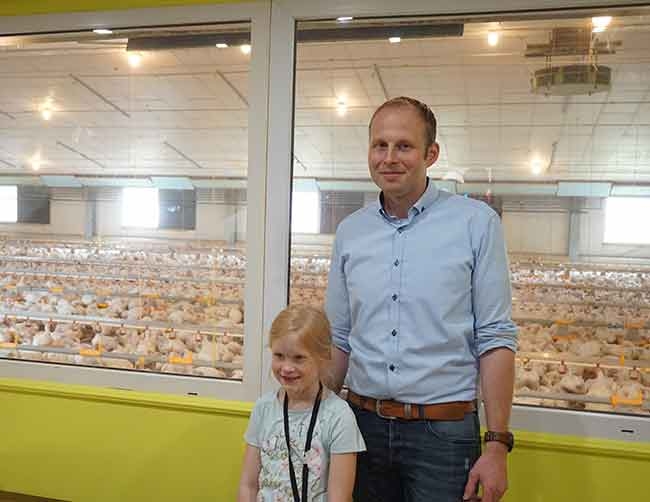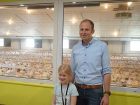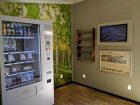
Nobody does it better
By Lilian Schaer
Features Business & Policy Consumer Issues Business/Policy Company News Global ProfilesStefan Teepker thinks farmers are the best people to show consumers in Germany where there food comes from.
 Stefan Teepker and his daughter Margaret stand in front of the viewing window in the visitor’s gallery.
Stefan Teepker and his daughter Margaret stand in front of the viewing window in the visitor’s gallery. In Lower Saxony, Germany, Stefan Teepker has just spent 25,000 € (approximately $36,500 CAD) on a new on-farm visitor gallery complete with food vending machine, video system and 24-hour viewing area on one of his poultry farms.
It’s not that he’s expecting the vending machine to be a big money maker – he needs 15 € a day in sales to make the venture work – but he’s hoping it will attract the non-farming public to his farm to learn more about how broiler chickens are raised, housed and treated in Germany.
Teepker unveiled his concept to a group of visiting international agricultural journalists who were touring northern and eastern Germany this past July.
It’s not easy being a farmer in Lower Saxony, where agriculture minister Christian Meyer represents the Green Party. Strict animal welfare rules, limitations on new barn constructions and looming new clean air laws mean farmers have a lot more to worry about than just raising healthy, quality livestock and poultry.
To Teepker’s way of thinking, that’s precisely why someone has to show people where their food comes from, and there’s nobody better to do that than farmers themselves.
“We have to show how we produce the meat people eat and with this new viewing area, people can come here any time to watch our birds,” he explained while looking into his bright, modern barn filled with healthy, contented birds. “Some farmers say we can’t do this job, someone else should – but who else would that be?”
Doing nothing is not an option as the pressure from those opposed to livestock farming is already making itself felt.
For example, even enriched poultry cages will be phased out entirely in favour of all cage-free production by 2025, beak trimming will be banned by the end of 2016, and culling of male chicks will no longer be permitted in Lower Saxony by the end of 2017.
The state has also committed to reducing antibiotic use in agriculture by 50 per cent in five years, resulting in farmers having to notify the government each time they purchase antibiotics for livestock use.
And according to Teepker, Lower Saxony is no longer issuing building permits for new livestock barns, citing environmental concerns, and that it is very difficult to even secure permission to renew existing facilities. Farmers who wish to expand their production have no choice but to buy existing farms or relocate to other parts of Germany, he said.
“We built our first barn in 2009, where we got a permit in 12 months and built in six – it was two years in total from thought to bird. Now it is up to six years,” he said.
New clean air laws from the European Union designed to reduce emissions from intensive livestock operations will mean new costs too, he added.
Teepker farms together with his younger brother Matthias near Handrup, Lower Saxony, about 360 km north of Frankfurt. He’s in charge of the broiler side of their operation, which also includes pigs, biogas production and 350 hectares (approximately 865 acres) of crops.
In 2013 he purchased the farm where he has added the viewing gallery and renovated the 10-year old facilities. And although he considered expansion into Eastern Germany several years ago, he ultimately decided against it due to the high cost of farms.
Teepker is not alone among farmers in Germany adding viewing galleries into their livestock barns, but notes that his goes above and beyond the simple window and information card that most provide.
Videos available on demand, for example, demonstrate other aspects of his farm and the life cycle of his birds. Feed samples show what birds eat and feeders and waterers are on display to demonstrate how they eat and drink.
And the vending machine, which Teepker has stocked with chicken products, can sell anything from a single egg to a five kilogram bag of potatoes. This particular farm happens to be on a busy public cycling trail, so Teepker hopes his location – and the cold drinks he is including in the vending machine – will help draw people in.
If the viewing room and vending machine are successful on the broiler barn, there are plans for a similar installation on one of their pig barns too.
Facebook is his biggest audience, where “Landwirtschaft Teepker” and regular posts of photos and updates about farm activities have garnered more than 2,100 likes, but he’s also a keen supporter of video. His most popular online video, called a look into chicken production, has logged more than 78,000 views to date.
“YouTube is the new Google so you need to have video even if it isn’t the best,” he believes.
But nothing beats a face to face connection, which is why the Teepkers have also reached out to local schools, starting about five years ago with inviting kindergarten classes out to the farm and expanding to include twice yearly classroom visits with small birds. They also sponsor children’s soccer jerseys in the community.
And those public education efforts seem to be paying off.
“We are noticing changes in attitudes with parents and teachers – “where are the cages” is now the most asked question,” Teepker said, adding the most people don’t know that German broilers are not raised in cages. “I think and hope that we are doing a good job.”
Yet despite some success, Teepker is also a realist about the public pressures facing farmers and the challenges of reaching out to consumers who are increasingly distanced from farming and food production.
“This is a first step, but the discussion will never finish,” he believes.
Print this page


